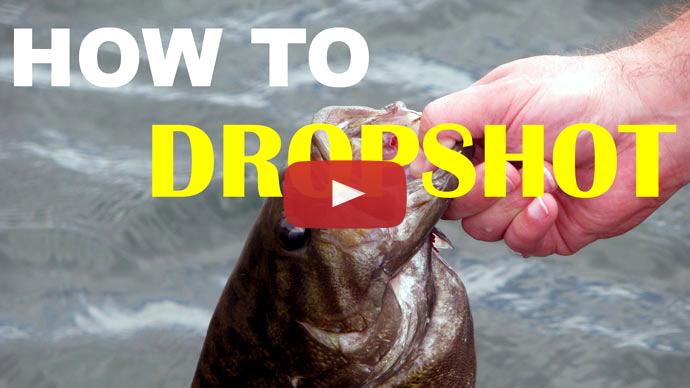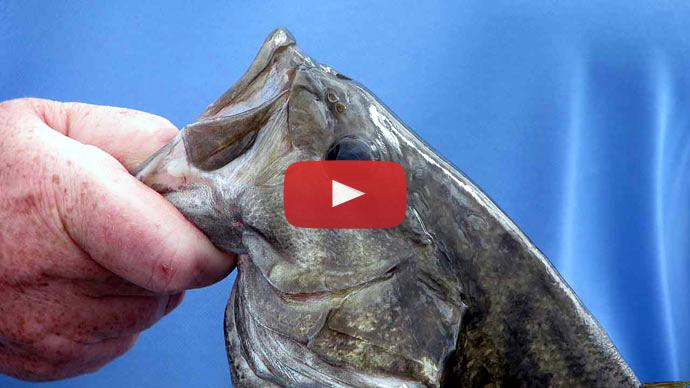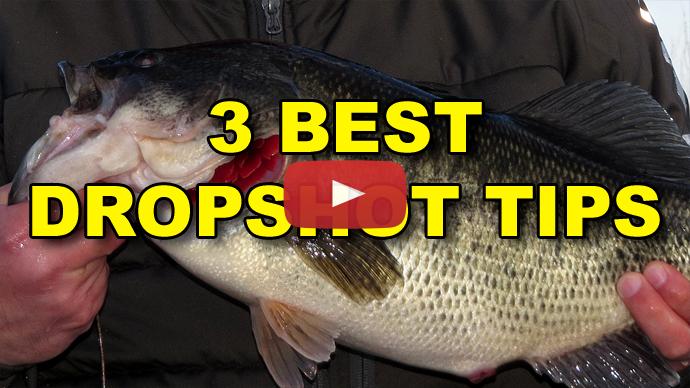Keri: Hey, you got something. Finally, he caught a fish on a drop shot.
Glenn: Here we go.
Keri: It's a little smallmouth.
Glenn: We'll take it. A little smallmouth on a drop shot. That'll do the trick.
Hey, folks. Glenn May here with BassResource.com. And today, let's talk about drop shotting, the basics. This is the essentials that you need to be successful with the drop shot rig. Now, you guys who've been fishing drop shots for a while, this pertains to you as well because there's some little tips and tricks you're gonna pick up on in here that you may not have heard before that's gonna make you be more successful on the water.
So drop shotting, the technique, first off is you make sure you're using it in the right conditions. It is not a type of technique to use to cover a lot of water and for finding fish.
Drop shotting is used once you've located the fish, you know they're sitting on a piece of structure or cover, and you wanna milk them out of that. Usually, when the bite isn't very good, it's when the fish is in a neutral to negative biting mode. Or you've gone through that area, you've picked up a bunch of fish that are actively chasing down crankbaits and spinnerbaits and you've caught those. You wanna go back through that area and methodically pick it apart to catch even more fish. That's when the drop shot shines. That's when it really does well. If you're trying to find fish with a drop shot, you might get a little frustrated with it because it's not as effective as doing that, simply because you're fishing really, really slow. And if you're not in an area where the fish are, you're gonna spend a lot of time casting and not catching.
So let's start off with the equipment here. What we're using is spinning gear, spinning outfit for many, many reasons. It starts off with the hook. Drop shot, you're typically using just a size 1 or 1/0 hook. This is a 1. This is a spin shot hook. Looks like that. It spins. If I can get it to spin, see that? And it doesn't spin the line. It twists. It doesn't twist the line. And I have a spin shot for two reasons. Number one, eliminates twist.
The other reason is that it allows the bait to move freely. And I can't stress this enough. With drop shotting, you need that bait to move as natural as possible. This is why I'm using the finesse hand-poured lure. It just wiggles and moves naturally in the water. It's very flexible and flimsy. See that? That's what you want because you need a very natural, natural presentation.
So with a small hook like that, a size 1 or 1/0 hook, it's a thin wire hook. By that nature, it means that you cannot put a ton of pressure on it, otherwise, you'll bend it out and you can lose a fish during a fight that way. It'll just work itself open and the fish'll break free. Or those thin hooks, because it's a 1 or 1/0 hook, it doesn't have a big bite to it and you can literally rip the hook out of the fish's mouth if you're using stout gear or heavy line or your equipment isn't matched properly. You could end up losing a lot of fish that way. And that's part of the frustration a lot of people have with the drop shot is they lose a lot of fish in this because, you know, they wanna blame the hook or something like that. It's because they don't have matched equipment. So let's talk about that a little bit.
Because we're using these small hooks the first thing you wanna do is use a light line. I'm using 6.2-pound Seaguar Fluorocarbon Finesse line. Yup, 6.2-pound. That's weird. Why 6.2-pounds?
Well, couple things. First of all, Seaguar, they invented fluorocarbon fishing line. And because of that, they create their own resin that's made specifically for fluorocarbon fishing line. They are in control of that. They don't buy it from a third party like other line manufacturers do. They make their own. They manufacture their own lines. So they are 100% in control of quality control the whole way. Because of that, they can make any pound they want.
In this case, 6.2-pound is what I like because it offers that real flexibility, allows the bait to move naturally in the water. It's not stiff. It allows it to bend and flex. It's got super sensitivity to it, which you need because the bite is gonna be subtle. So any kind of sensitivity that you can glean and put it in your favor, that's what you need, and that's what fluorocarbon does.
Fluorocarbon also is heavy. So it doesn't have any buoyancy to it. So it is neutral. As far as the bait's concerned, it's not gonna impede the action of that bait. Whereas braid, on the other hand, braid's buoyant. You're gonna get a bow on the line, it's gonna impede the action of that bait because it pulls back on it. It doesn't allow it to flow freely. Plus it's no stretch whatsoever. And on a light wire hook, that's exactly the opposite of what you want. You want a little stretch and give when you're fighting the fish so you don't bend that hook out. And braid will do that. I don't care if you're using a six-pound braid or not. It doesn't stretch. And that's a characteristic you don't want when you're using light hooks.
So I don't even use braid at all. Like, I don't have, like, a leader on it or anything like that because it defeats the purpose of using the fluorocarbon. I use some backing on here with braid, so I don't have to use all fluorocarbon because that's expensive. So I'll maybe use 60, 80 yards of fluorocarbon line with braid backing. But I'm not using, like, braid line with a leader, if that makes any sense. Because I want to use the advantages that fluorocarbon has for finesse fishing. So that's why I'm using 6.2-pound line.
Any heavier line, and it starts to impede the action of the bait. Seven-pound, 8-pound, 10-pound, it's just a little too wirey and the bait doesn't get to flow as freely as it should. So a six-pound line works really well for drop shot.
The rod itself is a medium-light powered, moderate action rod. Lots of bend and flex to it. I don't know if you can see that or not. I can bring this down a little bit, but, boy, it's got a lot of flex to it. That's what you want. It acts kind of like a spring. It kinda gives, when that fish surges, when you're fighting them back to the boat, it gives. It doesn't pull back on the fish, which is, again, can cause a problem with the hook. So you need that real light action. It's gonna work in concert with that line when that fish takes off and runs, it's gonna give a little bit, let that fish go. And that's why I'm using spinning gear here.
Spinning gears, the drag is this way. The discs are over here. So they're bigger discs and that way, they have greater surface area. So by nature, they have a smoother drag. And that's what you want or something like this, a nice smooth drag. When that fish makes that run, you want a nice, steady, slow pull. You don't want to go because that's just gonna work the hook loose when the fish is fighting. So a good, strong, steady drag is what you need for this type of deal, for drop shot fishing.
And then here I just got a teardrop-shaped drop shot weight. It's on a little swivel so it doesn't get snagged as much. Doesn't have to be a swivel, but I like to have a little swivel on it. This teardrop shape, now if I'm fishing in areas that have a little more rock in it, fishing deeper structure that's a little more chunky rock, then I might go to a straight cylinder shape drop shot because it doesn't get hung up as much in the rocks.
But I will not fish rip rap. I'm gonna save you guys a lot of frustration right now. Don't fish drop shot and rip rap. You're just gonna get frustrated because about every other cast you're gonna get stuck and you're probably gonna lose a lot of drop shot weights. So just don't do it. Don't fish rip rap, you know, chunk rock, that kind of stuff with drop shot. Other than that, it works very well in a lot of different areas. So speaking of that, now that you know the rig and how to set it up, let's go it.
Come here. All right.
Keri: He is not happy.
Glenn: Here we go.
Keri: What are you using, Glenn?
Glenn: Drop shot finesse worm.
All right. So again, you're targeting something very specific, say a point or a rock pile. I don't have one right here where I'm at, but I'm gonna try and demonstrate what I can best I can.
All you're gonna do is you're gonna throw it out there to that piece of structure and let the bait fall all the way down. Just let it fall. And a lot of times, the bite will happen while it's falling. So you just wanna watch the line. Watch it very, very carefully. Be on point for this because you'll just see a little twitch in your line, or it might jump a little bit, or it might swim off to one side. Lot of times, it just starts falling faster because the fish grabbed it and swimming away with it and the line just starts peeling off faster. Those subtle things, that's a bite because you're not gonna feel it because it's falling on slack line. So watch for that.
If you see something like that occur, reel down and set the hook. And you don't pop it really hard because the hook's already exposed to thin wire hooks. So you just lift. It's just a quick pull. And yet the fish will be hooked. You don't have to do anything harder than that.
But once it hits the bottom, reel up on the slack and you want a straight connection. You want your line to be a nice straight connection, straight down to the bottom. And don't do anything else. Just hold it tight and hold on to it. That's it. You don't wanna move it at this point.
You may think the bait is just sitting there limp and not doing anything, but actually it is. When you're trying to hold your hand steady for two minutes, you can't. You're not a statue, so it won't hold rock solid. Your hand is moving and that's transmitting little vibrations down the line. If there's a little breeze, little waves are lapping up and hitting the line and it's causing little vibrations down there and making the bait move. If there's a little bit of current down there, it's moving too. And you are moving. If you're on a boat, you're gonna be drifting just a little bit and that weight is moving along the bottom.
All that is causing that bait to just shimmy in place and move around and look alive. This is why you're using that light line with that VMC Spinshot hook, is letting that bait move naturally by itself. And you're not imparting a whole lot of action on it. You're just letting it do its thing. And a lot of times, you get bit that way. This is where you need that sensitivity in that line and in this rod because, again, the bites can be really soft. It might just get a little heavy, just load up a bit, boom, you got a fish, set the the hook. Well, I'll take it.
Keri: And I'll do the same.
Glenn: He was right on the drop.
Keri: Mine are right on the rock.
Glenn: Right where he's supposed to be.
Keri: At least yours are getting bigger or yours are bigger. I guess he's a little bit bigger than the last one I caught. Little bit.
Glenn: We doubled again, though they're not big ones, but, you know, it's fun.
Keri: That's right.
Glenn: Now, if I've been sitting here for a while and I get bored and I'm not catching any fish doing that, then I might just tweak it just a little bit. I'll just use my wrist and all I'm doing is I'm just shaking it just a little bit. I'm just moving it just like that. All I wanna do is I wanna see that line bounce. I don't know if you could see it or not with the camera. The line is just bouncing just a little bit. That's all you're trying to do, is get it to bounce. Your rod tip will bounce just a little bit but look at this bait dance around. Look at this. I'm doing exactly what I just showed you. Look how much it's dancing. See? It moves a lot, even though you may not think it is. It's moving a lot and that's what you want. You just give that little bit of motion to attract the nearby bass. It's in that neutral to negative feeding mode, he sees something that's alive, that's moving, he's gonna come check it out and he's gonna eat it. So that's all you need to do.
Once you've done that for a little while, you pause, you wait again, holding that line tight. You don't get bit, shake a little bit more, wait, you don't get bit, then you can lift up the rod and reposition that bait on that piece of structure and do it again. Rinse, lather, repeat. It's the same process. It's very slow and methodical.
It can be boring if you're on a piece of structure that doesn't have any fish and you're not getting bit, but at the same time, a lot of times, when the fish are in that negative to neutral feeding mode, it's the only thing they want. That's all they're gonna do is they'll bite something like this when nothing else will do.
In the summertime, I have a long leader like this, 18 inches. You want it up off the bottom. The fish are roaming around a bit. They're moving, so they're gonna see it. So you want it up a bit. If I'm fishing some sparse vegetation, I might go longer because I want this bait to be up above that vegetation where they can see it. So I'll go longer. In the colder months and in the winter, I'll shorten it up. I'll shorten that leader to maybe 8 or 10 inches because the fish are closer to the bottom and they're not willing to go up as much to chase a bait.
Now, one other technique I like to use, both summer and wintertime, is offshore structure like points, humps, ridges, rock piles work really well for this, ledges. What I'll do is I'll throw it out there. This is in 15, 20-foot, even deeper water. In the dead of winter, I'm fishing 45 feet deep. I'll throw it out there and I'll use the boat and the breeze to drag that bait over that cover.
So in those instances, all I'm doing is I've just got my rod out here and I just got my rod tip down towards the water, almost touching the water, and I'm just dragging it real slow. If there's no wind at all, I'll put the trolling motor maybe on 10 to 20, somewhere in there. Real slow drift over that cover.
In that instances, then I will use a little bit longer...even if it's dead of winter, use a longer tagging like this because, you see, you've got a bottom like this, you're in an angle, right? So even though you've got a long tag end, the bait's only just far off the bottom. So keep that in mind. Use a little bit longer if you're gonna drag that technique.
But that is really deadly in the wintertime or in the dead of summer when the fish are in those deeper, deeper structure areas, they're not willing to bite, you can just drift over it and just take your rod tip and give it a little shake every now and then while you're drifting over it and they grab it, take off with it. It's great way of fishing.
Not super exciting because it's not super aggressive, but a lot of times that's the only way the fish are gonna bite. And you better know how to do this technique when that's the only way they're gonna bite it.
So that's drop shotting 101. I hope that helps. For more tips and tricks like this, visit BassResource.com.



